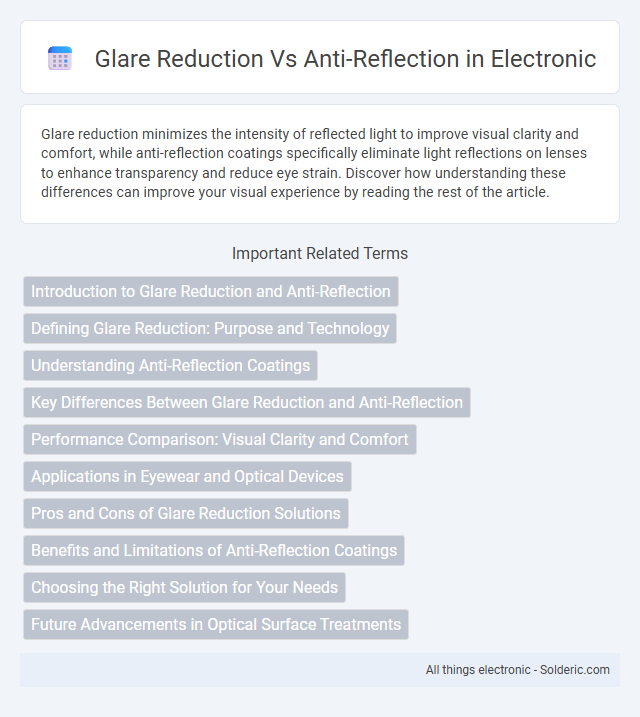Glare reduction minimizes the intensity of reflected light to improve visual clarity and comfort, while anti-reflection coatings specifically eliminate light reflections on lenses to enhance transparency and reduce eye strain. Discover how understanding these differences can improve your visual experience by reading the rest of the article.
Comparison Table
| Feature | Glare Reduction | Anti-Reflection |
|---|---|---|
| Primary Purpose | Minimizes intense light reflections causing discomfort | Reduces surface reflections to enhance clarity and visibility |
| Technology | Matte coatings, polarized films | Multi-layer optical coatings |
| Effect on Vision | Decreases glare-related eye strain and improves comfort | Improves image contrast and reduces visual distractions |
| Common Applications | Eyewear lenses, automotive displays, screens | Camera lenses, eyeglasses, smartphone screens |
| Surface Appearance | Typically matte or diffused finish | Clear, glossy finish |
| Cost Implication | Generally lower cost solutions | Usually higher cost due to specialized coatings |
Introduction to Glare Reduction and Anti-Reflection
Glare reduction technology minimizes excessive brightness caused by external light sources, enhancing visual comfort and reducing eye strain in your daily activities. Anti-reflection coatings work by decreasing surface reflections on lenses or screens, improving clarity and contrast for sharper images. Both features improve visibility but target different optical challenges to optimize your viewing experience.
Defining Glare Reduction: Purpose and Technology
Glare reduction technology aims to minimize the intensity of bright light reflections on surfaces, enhancing visual comfort and clarity by diffusing or absorbing excessive light. It typically employs specialized coatings or materials that scatter incoming light, preventing direct reflections that cause eye strain or impaired vision. Unlike anti-reflection coatings, which primarily reduce light reflection by destructive interference, glare reduction focuses on controlling light intensity to improve visibility in high-glare environments.
Understanding Anti-Reflection Coatings
Anti-reflection coatings minimize light reflection on surfaces, enhancing visual clarity and reducing eye strain. Unlike general glare reduction techniques, these coatings use multiple dielectric layers to cancel reflected light waves, which improves screen brightness and contrast. Understanding anti-reflection coatings helps you choose eyewear or screen protectors that optimize visual comfort and clarity.
Key Differences Between Glare Reduction and Anti-Reflection
Glare reduction minimizes harsh light reflections by diffusing or absorbing light to improve visual comfort, while anti-reflection coatings specifically reduce surface reflections on lenses or screens, enhancing clarity and contrast. Glare reduction techniques are often applied through polarized lenses or matte screens, whereas anti-reflection involves specialized coatings that cancel reflected light waves. Understanding these key differences helps you choose the right solution for eye strain relief or improved optical performance.
Performance Comparison: Visual Clarity and Comfort
Glare reduction technology minimizes reflections and bright light interference, enhancing visual comfort by reducing eye strain during prolonged screen use. Anti-reflection coatings improve visual clarity by eliminating surface reflections, resulting in sharper images and more accurate color perception. Your choice between glare reduction and anti-reflection depends on whether you prioritize comfort in bright environments or optimal image quality for detailed tasks.
Applications in Eyewear and Optical Devices
Glare reduction in eyewear and optical devices improves visibility by minimizing bright light reflections that can cause discomfort or impair vision, especially in outdoor and high-glare environments. Anti-reflection coatings enhance optical clarity by reducing surface reflections on lenses, increasing light transmission and contrast, which is crucial for precision instruments like cameras, microscopes, and prescription glasses. You benefit from combined glare reduction and anti-reflection technologies through improved comfort, clearer vision, and enhanced performance in both everyday eyewear and specialized optical equipment.
Pros and Cons of Glare Reduction Solutions
Glare reduction solutions improve screen visibility by minimizing light reflection and eye strain, enhancing comfort in bright environments. Pros include reduced glare from ambient light and improved contrast without altering screen color, while cons involve potential reduced screen brightness and possible color distortion depending on the technology. Compared to anti-reflection coatings, glare reduction often prioritizes eye comfort but may sacrifice some image clarity.
Benefits and Limitations of Anti-Reflection Coatings
Anti-reflection coatings significantly enhance screen visibility by minimizing light reflection and glare, improving your viewing experience in bright environments. These coatings increase contrast and reduce eye strain, making them ideal for smartphones, computer monitors, and eyewear. Limitations include susceptibility to scratches and potential difficulty in cleaning, which may require gentle maintenance to preserve their effectiveness.
Choosing the Right Solution for Your Needs
Glare reduction technology minimizes reflected light to enhance visual comfort in bright environments, making it ideal for outdoor activities or screen use under direct sunlight. Anti-reflection coatings target the elimination of internal reflections on lenses and screens, improving clarity and contrast, especially in photography, eyewear, and display devices. Selecting between glare reduction and anti-reflection depends on specific needs: choose glare reduction for reducing eye strain in high-glare settings and anti-reflection for maximizing image quality and detail.
Future Advancements in Optical Surface Treatments
Future advancements in optical surface treatments promise significant improvements in glare reduction and anti-reflection technologies through nanostructured coatings and adaptive materials that dynamically adjust to lighting conditions. These innovations enhance visual clarity, reduce eye strain, and increase durability by minimizing surface reflections and scattering. Your devices and eyewear will benefit from smarter, more efficient optical surfaces that optimize performance in varied environments.
Glare Reduction vs Anti-Reflection Infographic

 solderic.com
solderic.com